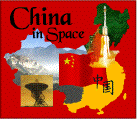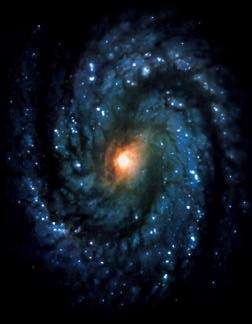 |
Chinese Astronomy |
Astronomy truly is an ancient science in China. In fact, mankind's first record of an eclipse of the Sun was made in China in 2136 BC.
Zhengtong, a Ming Dynasty ruler of China from 1436-1449, had the Ancient Beijing Observatory built at the southeast corner of the old city wall. A 46-ft.-high platform held eight Qing Dynasty bronze astronomical instruments. Two were built in 1439 and six in 1673.
 Dark Ages. During Europe's Dark Ages, the flourishing civilization in China, as well as those in Arabia and India, achieved major advances in science, technology, medicine, mathematics and astronomy. China invented paper, gunpowder and the compass. The Chinese printed books using movable type in 1050.
Dark Ages. During Europe's Dark Ages, the flourishing civilization in China, as well as those in Arabia and India, achieved major advances in science, technology, medicine, mathematics and astronomy. China invented paper, gunpowder and the compass. The Chinese printed books using movable type in 1050.
Guest Star. A "guest star" was seen by the Chinese in 1054. The supernova explosion was witnessed in the area of Earth's sky where today we see an expanding gas cloud that we call Crab Nebula. The "guest star" was so bright it was visible in daylight.
A Chinese document written on July 4, 1054, describes a star that appeared suddenly in the sky not far from the Moon and near the star known today as Zeta Tauri.
"In the 1st year of the period Chih-ho, the 5th moon, the day chi-ch'ou, a guest star appeared... After more than a year it gradually became invisible..."
Similar accounts of the supernova are in other historical Chinese writings, as well as in pictographs found in the American southwest.
Today, the Crab Nebula appears in the sky as an oval, hazy patch that became the first entry in the catalog of such objects by the comet hunter Messier (M1). Only long-exposure photographs reveal the Crab to be an expanding cloud of glowing gas.
1604 Supernova. A bright supernova explosion, visible to the naked eye in the constellation Ophiuchus in October 1604, was discovered by astronomers in China as well as in Korea and Europe. The 1604 supernova is referred to as Kepler's Star after the astronomer who determined its position. The supernova involved Galileo in his famous dispute with Aristotelian philosophers who said the heavens couldn't change. Using parallax equations, Galileo said the new star was very distant, in the area Aristotelian philosophers presumed to be invariable.
Compass. In the 12th century, the Chinese started using magnetic compasses so their ocean-going ships to find their way in any weather.
Fire Arrows. A Syrian scholar in 1280 described "Fire Arrows," which probably were rockets.
Who's on first? Entering the 17th century, the Chinese thought they led the world in science -- until visiting Jesuits demonstrated European astronomy including a clock that predicted the movements of stars. To test the clock, an eclipse of the Sun was predicted by both Chinese and European astronomers. The Chinese-predicted hour came and went with no eclipse. Meanwhile, Western science challenged Chinese superiority when the eclipse occured at the moment the Jesuits had predicted.
20th Century. The Peoples republic of China installed in 1990 what it called the world's largest reflecting horizontal meridian circle telescope at the Chinese Academy of Sciences' Shaanxi Observatory.
The meridian circle telescope is used to determine the times at which stars cross the the meridian. It was designed by a Danish astronomer and built at the Nanjing Astronomical Instrument Factory for the Shaanxi Observatory.
The 420-mm-diameter telescope to observe distant stars can provide accurate locations for more than 10,000 stars a year.
Multi-Channel solar. Nanjing Astronomical Instrument Factory also built a multi-channel solar telescope for a Chinese Academy of Sciences observatory in Huariou County near Beijing. It has six lenses and 14 channels. The multi-channel solar telescope, which the Chinese said was the first of its kind, produced fine images. Leading Chinese astronomers called the telescope a solar physics breakthrough.
Mobile field lab. A mobile open-air astronomy observatory was opened by the Chinese Academy of Sciences in 1990. The field lab has a 7-ft. optical telescope, a 4-ft. infrared telescope, a solar magnetic field telescope and others.
Celestial globe. China's Purple Mountain Observatory constructed a new multifunctional globe. It not only shows the movement of celestial bodies, but also forecasts their exact positions and answers questions about astronomy. Astronomers there regard it as the best celestial globe ever produced in China.
The globe is used for teaching, aviation, navigation and astronomy. The celestial globe looks like a terrestrial globe, but depicts more than 1,000 stars on its 32-cm.-diameter surface.
Galaxy Noise At South Pole. Scientists at work in Antarctica near Earth's South Pole are able to hear galaxy noise. Australian specialists in upper-atmosphere physics hear it at Casey Station in the Australian Antarctic Territory on the Greater Antarctica mainland at Budd Coast, Wilkes Land, on the Vincennes Bay of the Southern Ocean.
A physicist from the Peoples Republic of China worked with the Australian engineers. During the Antarctic winter of 1989, when there were few daylight hours and daytime temperatures were about 10 below zero Fahrenheit, they set up a small geophysical observatory to monitor Earth's magnetic field as well as ionized layers of this planet's atmosphere up to altitudes of 300 miles. About twice a week, they measured the magnetic field and radioed the data by space satellite to the Bureau of Mineral Resources at Canberra, Australia.
Learn More About China in Space
Shenzhou 5 and Yang Liwei:
Chinese Lunar Exploration:
Chinese Space Launch Sites:
Chinese Space Rockets:
Chinese Space Satellites:
China's space industry:
Learn more about China:
Search STO
STO Cover
About STO
Email
Questions
Suggestions
© 2005 Space Today Online


Dark Ages. During Europe's Dark Ages, the flourishing civilization in China, as well as those in Arabia and India, achieved major advances in science, technology, medicine, mathematics and astronomy. China invented paper, gunpowder and the compass. The Chinese printed books using movable type in 1050.